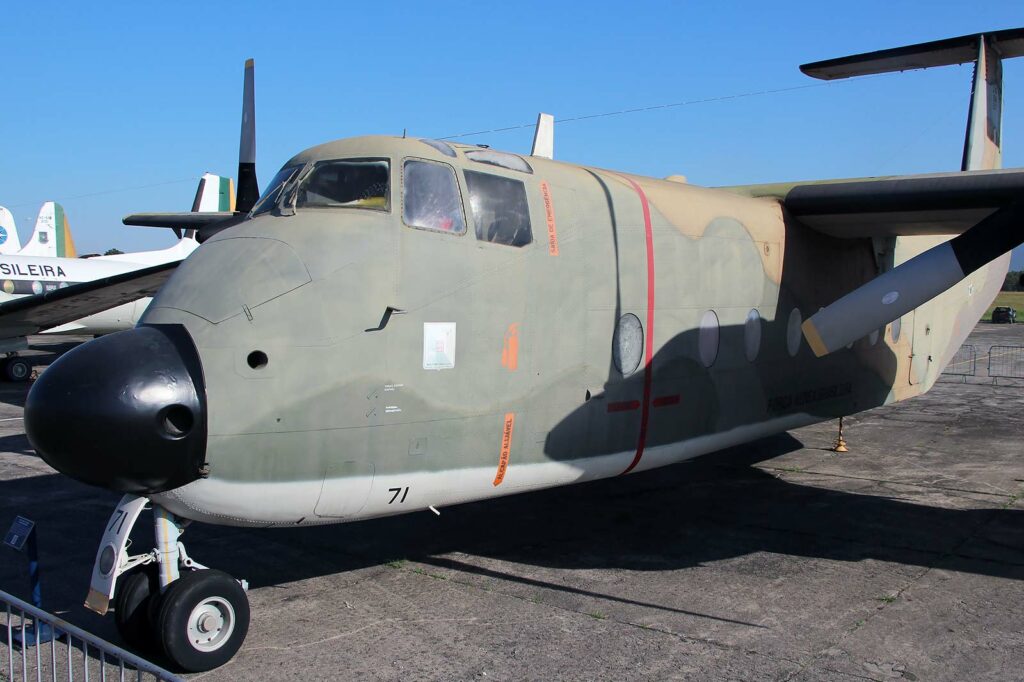The de Havilland Canada DHC-5 Buffalo is a versatile twin-turboprop STOL utility transport aircraft, known for its robust performance in diverse environments.
In Brief
The de Havilland Canada DHC-5 Buffalo is a short takeoff and landing (STOL) aircraft, designed primarily for cargo, troop transport, and medevac operations. Developed in the 1960s, it features high-wing, twin-turboprop engines, and a rugged landing gear, enabling operations from unprepared runways. The Buffalo is distinguished by its excellent STOL performance, significant payload capacity, and operational versatility, serving in various military and humanitarian roles worldwide. Its ability to operate in austere conditions makes it particularly valuable for disaster relief missions and remote area operations, embodying a blend of reliability, durability, and utility.
The de Havilland Canada DHC-5 Buffalo represents a significant advancement in STOL aircraft design, developed to meet the growing demands for versatile and reliable utility transport.

History of the Development of the de Havilland Canada DHC-5 Buffalo
In the context of the 1960s, there was a notable demand for a versatile transport aircraft capable of STOL operations, prompting de Havilland Canada to develop the DHC-5 Buffalo. This aircraft was designed to fulfill a variety of roles, including troop transport, cargo airlift, and medevac, specifically in environments that required short takeoff and landing capabilities. The development program was initiated following the success of the company’s previous STOL aircraft, the DHC-4 Caribou, with the aim of offering enhanced performance, greater payload capacity, and improved operational flexibility.
The DHC-5 Buffalo first flew on April 9, 1964, demonstrating its robust STOL capabilities from the outset. While not assigned a specific NATO nickname, the Buffalo quickly proved its worth, showcasing an ability to operate from rugged, unprepared airstrips while carrying considerable loads, making it an ideal aircraft for military, humanitarian, and civilian use, particularly in remote or challenging environments.
Design of the de Havilland Canada DHC-5 Buffalo
The DHC-5 Buffalo’s design is centered around STOL performance and versatility. It features a high-mounted wing and large, upswept tail, which, along with powerful twin General Electric T64 turboprop engines, allow for impressive short-field performance. The aircraft’s robust landing gear is designed to withstand rough terrain, enabling operations from undeveloped airstrips.
The spacious cargo hold is equipped with a rear-loading ramp, facilitating easy loading and unloading of cargo, vehicles, and personnel. The cabin can be quickly reconfigured for various missions, from transporting cargo to carrying passengers or evacuating casualties. However, the emphasis on STOL capabilities and payload capacity means the aircraft is not optimized for speed, resulting in lower cruise speeds compared to other transport aircraft in its class.
Performance of the de Havilland Canada DHC-5 Buffalo
The Buffalo’s performance is characterized by its exceptional STOL capabilities, allowing it to operate from airstrips as short as 800 feet. With its twin GE T64 engines, it can achieve a maximum speed of around 330 km/h (205 mph) and has a range of up to 2,240 km (1,392 miles) with a standard payload. Its service ceiling reaches approximately 30,000 feet, enabling overflight of challenging terrain.
Comparatively, the DHC-5 stands out for its STOL performance and ruggedness, especially against aircraft like the C-130 Hercules, which, while faster and with a higher payload, requires longer runways for takeoff and landing. The Buffalo’s ability to access remote and undeveloped areas makes it uniquely valuable for certain military and humanitarian missions.
Variants of the de Havilland Canada DHC-5 Buffalo
The DHC-5 Buffalo was produced in several variants, adapting to different operational requirements:
- DHC-5A: The initial production version designed for military transport.
- DHC-5C: An improved version with uprated engines and increased fuel capacity.
- DHC-5D: The most widely used variant, featuring further enhancements in performance and capability.
Each variant maintained the Buffalo’s distinctive STOL performance while incorporating improvements to meet the evolving needs of operators in various environments.

Military Use and Combat of the de Havilland Canada DHC-5 Buffalo
The DHC-5 Buffalo has seen extensive military service with various armed forces around the world. Its operational roles have included troop transport, logistical support, humanitarian aid, and disaster relief. The aircraft’s robust design and reliable performance have made it particularly useful in conflict zones and remote areas, where its ability to quickly transport personnel and materiel has been invaluable.
While primarily used in non-combat roles, the Buffalo has participated in numerous military operations, demonstrating its capability to operate under challenging conditions and contribute effectively to mission success. Its service record underscores the aircraft’s adaptability and reliability across a range of demanding operational scenarios.
The de Havilland Canada DHC-5 Buffalo exemplifies the pinnacle of STOL utility aircraft design, combining robust performance, considerable payload capacity, and exceptional versatility. Its enduring legacy in military and humanitarian operations worldwide highlights its effectiveness in fulfilling the diverse requirements of its operators. The Buffalo’s ability to access remote and austere environments, coupled with its dependable service record, cements its status as a valuable asset in aviation history, particularly in roles where operational flexibility and STOL capabilities are paramount.
Back to Transport planes.